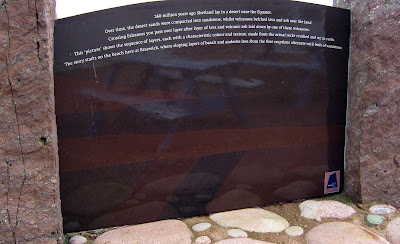The Walls Boundary Fault is part of the Great Glen fault system. The fault is so called because it forms the boundary of the Walls peninsula on the west side of Shetland. Rocks on opposite sides of the fault - Granite on the east side and the much softer schist on the west side have moved relative to each other for more than 100km. The fault line as it enters the sea at Ollaberry is the best exposure of this feature anywhere in Britain as the schist has been eroded by the sea but the harder granite has remained. See the interpretive board to the left of the fault for more information.
The fault line is visible on the top of the hill as a small ditch. Follow the ditch to its northern end to find the beach where the fault is exposed.
The view looking from the top down to the beach. Its not difficult to walk down unaided but it is steep in a few places and care is needed as there are lots of loose rocks, and at this time of the year its also very wet.
There's a sandy beach at the bottom (Back Sand), and the fault line is impressive looking from the beach. The granite headland is named Saberstone.
The 'Back Sand' beach extends round to the north of the bay. Further along tthe beach there were fresh otter tracks along with an obvious otter feeding area consisting of several fish skeletons under a large pile of boulders.
To get there, head to Ollaberry in the north Mainland. Turn right at the Ollaberry Post Office and park in the area above the Ollaberry slipway. Go through the gate to the left of the Kirk and head north. Climb over the stile at the north end of the Kirk, keep heading north until you come to the next stile and then head north-west until you find the ditch that is the fault. Follow that to the north to find the access to the beach. The route to the fault is in red - the blue dashed line is the fault line.
The climb down to the beach was fine for my 9 and 11 year olds & its an excellent beach. Its probably best to go at low tide so more of the beach is exposed. Here's a view of Ollaberry from the hill above the kirk.











































































